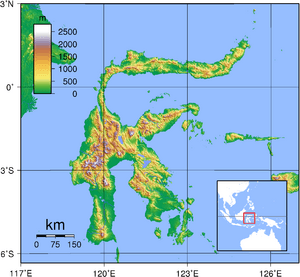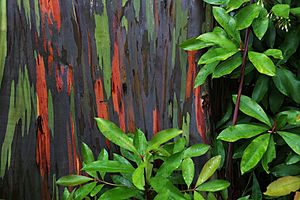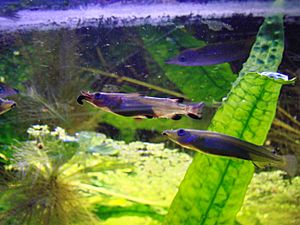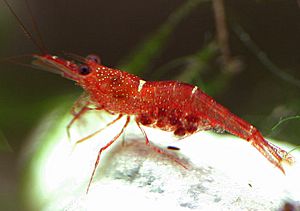Sulawesi facts for kids
Quick facts for kids
Sulawesi
|
|
|---|---|
| Elevation | 3,478 m (11,411 ft) |
| Population
(2019 estimate)
|
19,573,800 |
Sulawesi, also called Celebes, is a large island in Indonesia. It is one of the four main islands known as the Greater Sunda Islands. Sulawesi is the eleventh-largest island in the world.
This island is located east of Borneo and west of the Maluku Islands. To its south are Mindanao and the Sulu Archipelago. In Indonesia, only Sumatra, Borneo, and Papua are bigger. Also, only Java and Sumatra have more people living on them.
Sulawesi has a unique shape with four long parts, called peninsulas. These are the northern Minahasa Peninsula, the East Peninsula, the South Peninsula, and the Southeast Peninsula. Three large bays, or gulfs, separate these peninsulas. The Gulf of Tomini is between the northern Minahasa and East peninsulas. The Tolo Gulf is between the East and Southeast peninsulas. The Bone Gulf is between the South and Southeast peninsulas. The Makassar Strait runs along the west side of the island. It separates Sulawesi from Borneo.
Contents
Geography of Sulawesi
Sulawesi is the eleventh-largest island globally, covering about 174,600 square kilometers. The island is surrounded by other lands and waters. To the west is Borneo, to the north are the Philippines, and to the east is Maluku. To the south, you'll find Flores and Timor.
The island has a very distinct shape, with its four large peninsulas. The middle part of Sulawesi is very mountainous and rugged. This means that the peninsulas have traditionally been quite separate from each other. It was often easier to travel between them by sea than by road.
Plants and Animals of Sulawesi
Sulawesi is part of a special area called Wallacea. This means it has a mix of plants and animals from both Asia and Australia. These species reached the island by crossing deep ocean waters. One unique tree found here is the Eucalyptus deglupta, also known as the rainbow eucalyptus, because of its colorful bark.
The island has 8 national parks. Four of these parks are mostly marine, protecting ocean life. The largest parks on land are Bogani Nani Wartabone National Park (2,871 km²) and Lore Lindu National Park (2,290 km²). Bunaken National Park, known for its amazing coral reefs, might become a UNESCO World Heritage Site.
Mammals of Sulawesi
Sulawesi is home to 127 types of native mammals. A large number, 62% (79 species), are endemic. This means they are found only on Sulawesi and nowhere else in the world.
The largest endemic mammals are the two types of anoa, which are dwarf buffaloes. Other hoofed animals here include the Celebes warty pig and the babirusas, which are unusual pigs. The only native meat-eating mammal is the Sulawesi palm civet.
The island also has many nocturnal tarsiers, which are small primates with big eyes. There are also diurnal macaques, which are monkeys active during the day. While most mammals on Sulawesi are like those in Asia, there are also cuscuses. These are tree-dwelling marsupials that came from Australia.
Sulawesi has many unique types of rodents. These include several kinds of mice, rats, and squirrels found only on the island or nearby small islands. Over 20 types of bats live on Sulawesi, but only some of them are endemic. There are also three types of endemic shrews.
Birds of Sulawesi
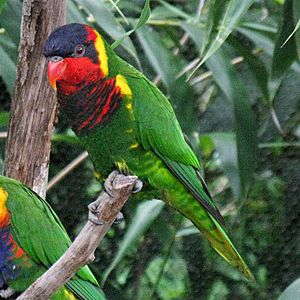
Unlike mammals, many bird species found on Sulawesi also live on nearby islands like Borneo. However, 31% of Sulawesi's birds are still unique to the island.
One special bird is the maleo. This chicken-sized bird mostly lives on the ground. It sometimes uses hot sand near volcanoes to warm its eggs. Groups are working to protect the nesting areas of these birds. Other birds found only on Sulawesi include the flightless snoring rail, the fiery-browed starling, and the Sulawesi masked owl. In total, there are about 350 known bird species on Sulawesi.
Reptiles of Sulawesi
The larger reptiles on Sulawesi are not unique to the island. These include reticulated and Burmese pythons, king cobras, and water monitors. You can also find sailfin lizards, saltwater crocodiles, and green sea turtles.
Long ago, a giant tortoise called Megalochelys atlas lived here but disappeared. It might have vanished when humans arrived. It seems that komodo dragons or similar large lizards also once lived on the island. Sulawesi also has many smaller snakes and lizards that are found only there.
Amphibians of Sulawesi
Sulawesi is home to several unique frogs. These include the Hylarana celebensis and different types of Limnonectes and Occidozyga frogs. There are also two types of endemic "flying frogs" called Rhacophorus edentulus and Rhacophorus georgii.
Freshwater Fish of Sulawesi
Sulawesi has over 70 types of freshwater fish, with more than 55 found nowhere else. A special group of fish called Nomorhamphus (viviparous halfbeaks) has 12 species found only on Sulawesi.
Most of Sulawesi's freshwater fish are ricefishes, gobies, and Telmatherinid sail-fin silversides. The Telmatherinid family is almost entirely found only on Sulawesi. They live especially in the Malili Lake system, which includes Lake Matano and Lake Towuti. Another unique fish is Lagusia micracanthus, one of the smallest grunters. The gudgeon Bostrychus microphthalmus is the only known cave-adapted fish from Sulawesi.
Freshwater Crabs and Snails of Sulawesi
Many types of Caridina freshwater shrimp and parathelphusid freshwater crabs are found only on Sulawesi. Some of these species are very popular in the aquarium hobby. Because many live in only one lake system, they are at risk from habitat loss and overexploitation. There are also unique cave-adapted shrimp and crabs, especially in the Maros Karst area. One crab, Cancrocaeca xenomorpha, is known as the "most highly cave-adapted species of crab in the world."
The freshwater snail group Tylomelania is also unique to Sulawesi. Most of these snails live only in Lake Poso and the Malili Lake system.
Other Interesting Animals
In the waters off Sulawesi's coast, you can find the Indonesian coelacanth, a very old type of fish. The amazing mimic octopus, which can imitate other sea creatures, also lives here.
Images for kids
-
Megalithic stone in Central Sulawesi
-
Hand stencils in Pettakere Cave in Maros
-
Toraja burial site with Tau-tau statues in cliff niches.
See also
 In Spanish: Célebes para niños
In Spanish: Célebes para niños


